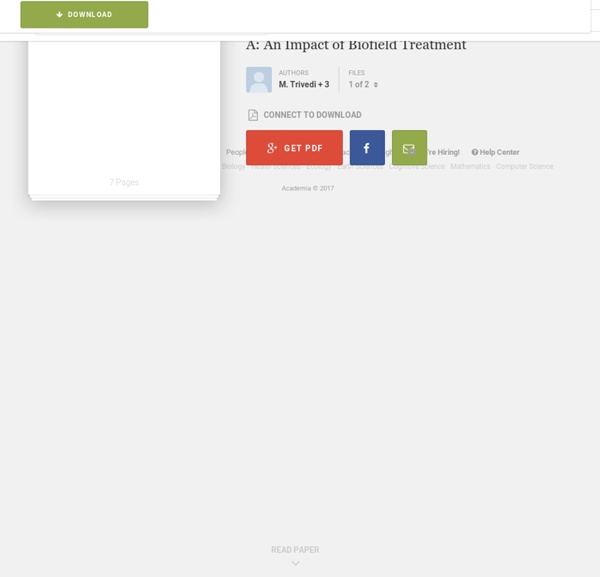



S. paratyphi – Alternative Strategy for Enteric Fever Enteric fever is a major global problem. Emergence of antimicrobial resistance threatens to render current treatments ineffective. The current study was attempted to investigate the effect of biofield treatment on Salmonella paratyphi A (S. paratyphi A) in terms of antimicrobial susceptibility assay, biochemical characteristics and biotyping. S. paratyphi A strain were procured from MicroBioLogics in sealed packs bearing the American Type Culture Collection (ATCC 9150). Alteration in Antimicrobial Susceptibility Pattern of Salmonella Paratyphi responding into useful way that is called biofield energy and the process is known as biofield treatment. Mr. Trivedi’s unique biofield treatment is also known as The Trivedi Effect®. Trivedi’s biofield treatment has been known to transform the structural, physical and thermal properties of several metals in material science [14-16], improved the overall productivity of crops [17,18], altered characteristics features of microbes [19-21] and improved growth and anatomical characteristics of various medicinal plants [22,23]. Due to the clinical significance of this organism and literature reports on biofield treatment as an alternative approach, the present work was undertaken to evaluate the impact of biofield treatment on paratyphi A in relation to antimicrobials susceptibility, minimum inhibitory concentration (MIC) and biotyping based on various biochemical characters. Materials and Methods S. paratyphi A, American Type Culture Collection (ATCC 9150) and B. conditions until further use. Gr. biotyping.
Human Biofield Energy influence on Salmonella paratyphi A Abstract Enteric fever is a major global problem. Emergence of antimicrobial resistance threatens to render current treatments ineffective. Citation Information Mahendra Kumar Trivedi. Energy Treatment Impact on the Characteristics of S. Paratyphi A Description Enteric fever is a major global problem. Emergence of antimicrobial resistance threatens to render current treatments ineffective. Citation Information Trivedi MK, Branton A, Trivedi D, Nayak G, Shettigar H, et al. (2015) Antimicrobial Susceptibility Pattern, Biochemical Characteristics and Biotyping of Salmonella paratyphi A: An Impact of Biofield Treatment. Huaman Aura on Antimicrobial Suspectibility Pattern of S. Paratyphi Enteric fever is a major global problem. Emergence of antimicrobial resistance threatens to render current treatments ineffective. The current study was attempted to investigate the effect of biofield treatment on Salmonella paratyphi A (S. paratyphi A) in terms of antimicrobial susceptibility assay, biochemical characteristics and biotyping.
Investigate The Impact of Biofield on Salmonella paratyphiA 0WordPress0CiteULike0 2 Enteric fever is a major global problem. Emergence of antimicrobial resistance threatens to render current treatments ineffective. The current study was attempted to investigate the effect of biofield treatment on Salmonella paratyphi A (S. paratyphi A) in terms of antimicrobial susceptibility assay, biochemical characteristics and biotyping. S. paratyphi A strain were procured from MicroBioLogics in sealed packs bearing the American Type Culture Collection (ATCC 9150). The study was conducted in revived and lyophilized state of S. paratyphi A. Your session has expired but don’t worry, your message has been saved.Please log in and we’ll bring you back to this page. Your evaluation is of great value to our authors and readers. Review When you're done, click "publish" Only blue fields are mandatory. Your mailing list is currently empty.It will build up as you send messagesand links to your peers. No one besides you has access to this list. Your message has been sent.
Evaluation of Serratia Marcescens- Trivedi Effect Serratia marcescens (S. marcescens) is Gram-negative bacterium, associated with hospital-acquired infections (HAIs), especially urinary tract and wound infections. The present study was aimed to evaluate the impact of biofield treatment on phenotyping and genotyping characteristics such as antimicrobial susceptibility, biochemical reactions, biotype, DNA polymorphism, and phylogenetic relationship of S. marcescens (ATCC 13880). The lyophilized cells of S. marcescens were divided into three groups (G1, G2, and G3). Control group (G1) and treated groups (G2 and G3) of S. marcescens cells assessed with respect to antimicrobial susceptibility, and biochemical reactions.
Analysis of Streptococcus Agalactiae Biochemical Characteristics Citation: Trivedi MK, Branton A, Trivedi D, Nayak G, Shettigar H, et al. (2015) Effect of Bioeld Energy Treatment on Streptococcus group B: A Postpartum Pathogen. J Microb Biochem Technol 7: 269-273. doi:10.4172/1948-5948.1000223 Volume 7(5): 269-273 (2015) - 270 J Microb Biochem Technol ISSN: 1948-5948 JMBT, an open access journal bioeld treatment that is also called as Trivedi eect . unique bioeld treatment has been known to transform the structural, physical, and thermal properties of several metals in material science [12-14], improved the overall productivity of crops [15,16], altered characteristics features of microbes [17-19] and improved growth and anatomical characteristics of various medicinal plants [20,21]. Due to the clinical signicance of this organism and literature reports on bioeld treatment, the present work was undertaken to evaluate the impact of bioeld treatment on S. agalactiae group B in relation to antimicrobials susceptibility and bio typing based on (Dade Behring
Spectral Properties of Disodium Hydrogen Orthophosphate Open Access Trivedi et al., J Chromatogr Sep Tech 2015, 6:5 Research Article Open Access Chromatography Separation Techniques o u r n a l f h m t g p y e i c q s Volume 6 • Issue 5 • 1000282 J Chromatogr Sep Tech ISSN: 2157-7064 JCGST, an open access journal Spectroscopic Characterization of Disodium Hydrogen Orthophosphate and Sodium Nitrate after Biofield Treatment Mahendra Kumar Trivedi1, Alice Branton1, Dahryn Trivedi1, Gopal Nayak1, Khemraj Bairwa2 and Snehasis Jana2* 1Trivedi Global Inc., 10624 S Eastern Avenue Suite A-969, Henderson, NV 89052, USA 2Trivedi Science Research Laboratory Pvt. *Corresponding author: Snehasis Jana, Trivedi Science Research Laboratory Pvt. Bhopal-462026, Madhya Pradesh, India, Tel: +91-755-6660006; Fax: +91-755- 6660006; E-mail: publication@trivedisrl.com Received July 25, 2015; Accepted August 10, 2015; Published August 20, 2015 Citation: Trivedi MK, Branton A, Trivedi D, Nayak G, Bairwa K, et al. (2015) doi:10.4172/2157-7064.1000282 Abstract